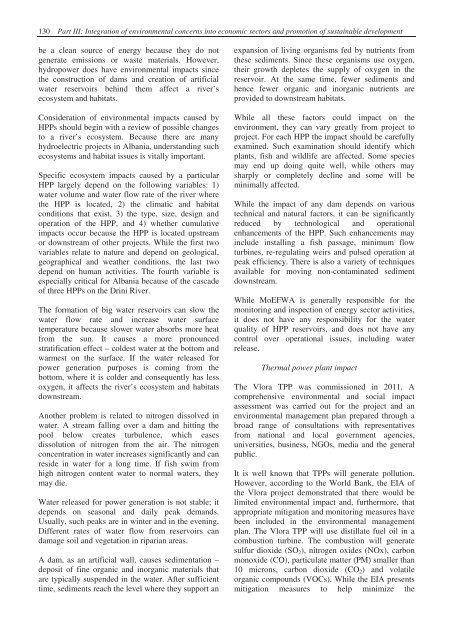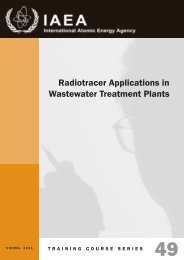Second Environmental Performance Review of Albania
Second Environmental Performance Review of Albania
Second Environmental Performance Review of Albania
You also want an ePaper? Increase the reach of your titles
YUMPU automatically turns print PDFs into web optimized ePapers that Google loves.
130 Part III: Integration <strong>of</strong> environmental concerns into economic sectors and promotion <strong>of</strong> sustainable developmentbe a clean source <strong>of</strong> energy because they do notgenerate emissions or waste materials. However,hydropower does have environmental impacts sincethe construction <strong>of</strong> dams and creation <strong>of</strong> artificialwater reservoirs behind them affect a river’secosystem and habitats.Consideration <strong>of</strong> environmental impacts caused byHPPs should begin with a review <strong>of</strong> possible changesto a river’s ecosystem. Because there are manyhydroelectric projects in <strong>Albania</strong>, understanding suchecosystems and habitat issues is vitally important.Specific ecosystem impacts caused by a particularHPP largely depend on the following variables: 1)water volume and water flow rate <strong>of</strong> the river wherethe HPP is located, 2) the climatic and habitatconditions that exist, 3) the type, size, design andoperation <strong>of</strong> the HPP, and 4) whether cumulativeimpacts occur because the HPP is located upstreamor downstream <strong>of</strong> other projects. While the first twovariables relate to nature and depend on geological,geographical and weather conditions, the last twodepend on human activities. The fourth variable isespecially critical for <strong>Albania</strong> because <strong>of</strong> the cascade<strong>of</strong> three HPPs on the Drini River.The formation <strong>of</strong> big water reservoirs can slow thewater flow rate and increase water surfacetemperature because slower water absorbs more heatfrom the sun. It causes a more pronouncedstratification effect – coldest water at the bottom andwarmest on the surface. If the water released forpower generation purposes is coming from thebottom, where it is colder and consequently has lessoxygen, it affects the river’s ecosystem and habitatsdownstream.Another problem is related to nitrogen dissolved inwater. A stream falling over a dam and hitting thepool below creates turbulence, which easesdissolution <strong>of</strong> nitrogen from the air. The nitrogenconcentration in water increases significantly and canreside in water for a long time. If fish swim fromhigh nitrogen content water to normal waters, theymay die.Water released for power generation is not stable; itdepends on seasonal and daily peak demands.Usually, such peaks are in winter and in the evening.Different rates <strong>of</strong> water flow from reservoirs candamage soil and vegetation in riparian areas.A dam, as an artificial wall, causes sedimentation –deposit <strong>of</strong> fine organic and inorganic materials thatare typically suspended in the water. After sufficienttime, sediments reach the level where they support anexpansion <strong>of</strong> living organisms fed by nutrients fromthese sediments. Since these organisms use oxygen,their growth depletes the supply <strong>of</strong> oxygen in thereservoir. At the same time, fewer sediments andhence fewer organic and inorganic nutrients areprovided to downstream habitats.While all these factors could impact on theenvironment, they can vary greatly from project toproject. For each HPP the impact should be carefullyexamined. Such examination should identify whichplants, fish and wildlife are affected. Some speciesmay end up doing quite well, while others maysharply or completely decline and some will beminimally affected.While the impact <strong>of</strong> any dam depends on varioustechnical and natural factors, it can be significantlyreduced by technological and operationalenhancements <strong>of</strong> the HPP. Such enhancements mayinclude installing a fish passage, minimum flowturbines, re-regulating weirs and pulsed operation atpeak efficiency. There is also a variety <strong>of</strong> techniquesavailable for moving non-contaminated sedimentdownstream.While MoEFWA is generally responsible for themonitoring and inspection <strong>of</strong> energy sector activities,it does not have any responsibility for the waterquality <strong>of</strong> HPP reservoirs, and does not have anycontrol over operational issues, including waterrelease.Thermal power plant impactThe Vlora TPP was commissioned in 2011. Acomprehensive environmental and social impactassessment was carried out for the project and anenvironmental management plan prepared through abroad range <strong>of</strong> consultations with representativesfrom national and local government agencies,universities, business, NGOs, media and the generalpublic.It is well known that TPPs will generate pollution.However, according to the World Bank, the EIA <strong>of</strong>the Vlora project demonstrated that there would belimited environmental impact and, furthermore, thatappropriate mitigation and monitoring measures havebeen included in the environmental managementplan. The Vlora TPP will use distillate fuel oil in acombustion turbine. The combustion will generatesulfur dioxide (SO 2 ), nitrogen oxides (NOx), carbonmonoxide (CO), particulate matter (PM) smaller than10 microns, carbon dioxide (CO 2 ) and volatileorganic compounds (VOCs). While the EIA presentsmitigation measures to help minimize the
















